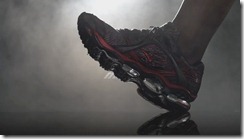 I want to begin this post by openly stating my personal bias (which is not going to come as a surprise to regular readers). I am a minimalist advocate, and believe that benefits can be accrued by avoiding overbuilt running shoes and modifying form to reduce things like dramatic heel striking and overstriding. That being said, I believe there are also cases in which heel striking is probably not a big deal. For example, I helped a local chiropractor (Brett Coapland) conduct a gait clinic last night for my local running club (Granite State Racing Team), and we filmed one runner who had overall good mechanics (e.g., not much overstride, asymmetry, etc.), but had a fairly pronounced heel strike and quite a bit of pronation. He’s been running for 15 years but has never had a serious injury. Our advice to him was don’t mess with success. Others had long injury histories and pretty dramatic overstriding gaits, and those would be the ones who might most benefit from a change in form/footwear.
I want to begin this post by openly stating my personal bias (which is not going to come as a surprise to regular readers). I am a minimalist advocate, and believe that benefits can be accrued by avoiding overbuilt running shoes and modifying form to reduce things like dramatic heel striking and overstriding. That being said, I believe there are also cases in which heel striking is probably not a big deal. For example, I helped a local chiropractor (Brett Coapland) conduct a gait clinic last night for my local running club (Granite State Racing Team), and we filmed one runner who had overall good mechanics (e.g., not much overstride, asymmetry, etc.), but had a fairly pronounced heel strike and quite a bit of pronation. He’s been running for 15 years but has never had a serious injury. Our advice to him was don’t mess with success. Others had long injury histories and pretty dramatic overstriding gaits, and those would be the ones who might most benefit from a change in form/footwear.
A few weeks ago I got an email from a PR rep for Mizuno offering to send me a pair of one of their “biggest shoe launches to date.” I was intrigued, thinking maybe Mizuno had joined the likes of Saucony and New Balance (and soon Brooks) in putting out a shoe for the minimalist market. However, once I saw the attached photos I knew this was not the case:
Here is Mizuno’s description of the shoe:
“The result of seven years of intense research and development, Wave Prophecy is our most advanced, most dynamic shoe ever. Our engineers designed Wave Prophecy to match your running gait and the natural spring rate of your muscles and tendons. Whether you land on your forefoot, midfoot or heel, Wave Prophecy’s full-length Infinity Wave plates propel you forward with a smooth ride mile after mile. No matter how far and how often you run, you’ll always have the ride of your life.”
Needless to say, I declined the offer of a trial pair, knowing that this shoe is nearly the polar opposite of what I look for in a running shoe. I actually kind of like the way it looks, but there’s simply way too much heel for my taste, it’s too heavy, too expensive ($200!!!), and I knew without even running in it that it would mess with my gait. My general policy is to decline any shoe that I would not consider buying myself as I don’t think I would be the right person to review such a shoe, nor would I want to run any significant number of miles in them.
Earlier today, my friend Bill Katovsky sent me a link to a positive review of the Mizuno Prophecy on Ransacker, and the included video was interesting to say the least:
In a running world where minimalism and encouragement of a midfoot/forefoot strike seems to be the big trend, Mizuno seems to have created the ultimate heel striking/overstriding running shoe. Don’t get me wrong, if you are a heel striker and simply don’t care about the stride debate, these might suit you just fine and the technology may actually be the best thing since sliced bread. However, for someone like me that feels that a shoe like this encourages overstriding, color me skeptical at best. Take a look at these stills captured from the Prophecy ad:
The first image is about as massive a heel strike as I have seen, and if you look at the apparent angle of the lower leg relative to the ground, it’s a tremendous overstride as well. The overstriding gait can also bee seen in the fourth image – it’s almost as if the little white dots represent pain points and the arrows are pointing to the foot position as the source of the trouble  .
.
I will give Mizuno some credit here – they include what may be the nicest slow motion view of a heel strike that I have ever seen, and you can really seen that the shoe does seem to cushion the impact (I do fully believe that if you heel strike, heel cushioning is essential):
It seems to me that Asics and Mizuno are the most resistant among the big manufacturers to the new minimalist trend. For example, check out the Asics ad for it’s top of the line Kinsei below (a “high-tech” $180 shoe):
I hope this will change with time as Mizuno does make some really nice shoes – the Wave Ronin and Wave Musha are solid transitional shoes, and the Wave Universe is a favorite of many minimalists. In fact the update to the latter is coming soon, and they have made what, from an appearance standpoint, was a pretty bland shoe into one that looks pretty sweet – check it out (from Running Warehouse):
I’d love to seem them expand on the Wave Universe concept with similar designs, and if they could lower the heel on the Ronin by about half, it would be a solid competitor to shoes like the Saucony Kinvara. As for the Prophecy – it’s not the shoe for me.
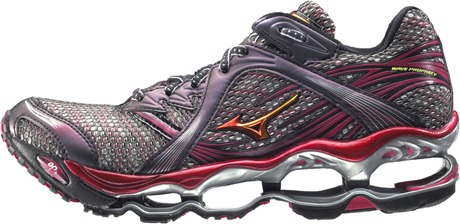
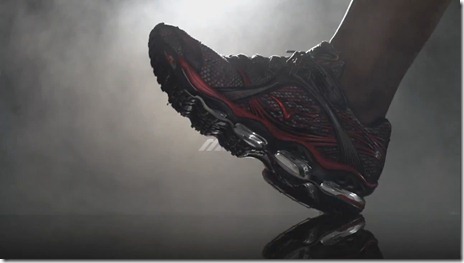
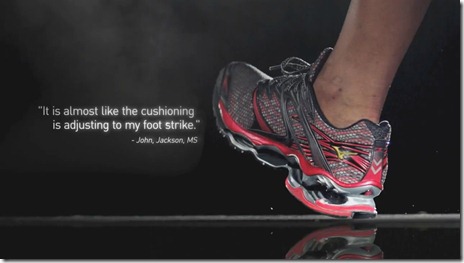
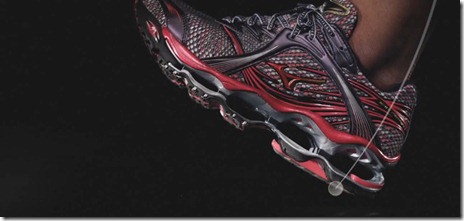
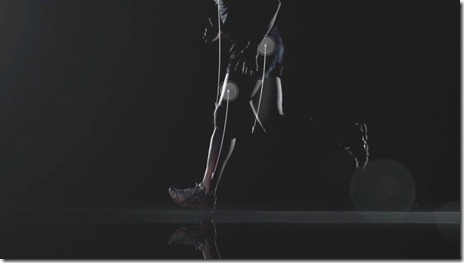

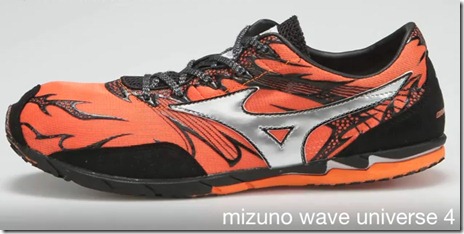














Do you think that the wave plate truly cushions as well as EVA? It seems like the plate wouldn’t work if the runner was abnormally light/heavy or applied a different amount of force to the ground. I have tried and liked the Wave Riders, but they never felt like they cushioned as well. Whats your opinion?
With the exception of my spikes I predominantly wear Mizuno – Wave Riders for most of my steady running & Wave Musha for faster stuff & racing. I generally am a midfoot/forefoot striker who prefers fairly lightweight & neutral shoes. I’m interested in the discussions around barefoot & minimalist running without ever having been keen to change dramatically due to my long streak of injury free training. I’m curious to know the thoughts of Pete & others on here regarding comparisons of the Musha (which I wear) and the Universe & Ronin (which I’ve never tried but have seen the reviews on here).
The Musha feels a bit firmer and less flexible than the others, but have only worn it a few times. The Universe is in a different world – way lighter, and much more flexible,
Hey that guy isn’t wearing any socks!
I have tried these on and they are the complete antithesis of minimal. If you never want even remotely perceive the surface on which you stand, walk or run these are the shoes for you.
Totally agree that two of the biggest shoe companies (Mizuno and Asics) are trying the hardest to not let the industry change. I even heard an Asics rep say “Asics does not believe in minimalism and that anything less than a 12mm heel to toe drop will not make any difference in someones gait.” Pretty bold statement!
This design of this shoe looks to be marketting driven rather than via biomechanics. It looks full of “high tech”, I guess there is part of the running market that easily seduced by this marketing angle, so wouldn’t be surprised if it sells.
Engineering wise EVA midsole will absorb more impact and provide less energy return than metal/plastic/carbon fibre springs, so I would expect this shoe to return slightly more engergy than a shoe with foam midsole, for a runner running with same gait in both shoes. If this shoes is any heavier than this will detract from this potential slightly improved efficiency.
However, I would expect that a forefoot landing will be more efficient than any heel strike gait, even with a “high tech” marketed shoe like the Prophacy. For me a lightweight flat and forefoot/midfoot will win every time from either a efficiency and lower loads perspective.
It’ll be interesting to see how marketting and shoe design evolve over the next decade. I suspect selling “less” of a shoe will take a little while to dominate the mainstream. Fingers crossed the viral nature of the internet might well be able to help speed the transition from crazy marketing and shoes like the Prophacy to shoes that are are designed to work positively with how the human body evolved to operate.
The mimimialist movement will need to shake down the science and practice good running form – it will need to counter the marketting jugganaunt behind built up shoes with facts and solid teaching. We’ll also have to avoid falling into the trap of being pigion holed as niche “hippy” market. Kudos to you Pete, this blog is part of the solution ;-)
Well, back in the day when I actually bought shoes based on the ‘cool heel super-cushion spring’, this would be on the top of my shoe list. Now I just cringe seeing these ads. These shoes are the painful reality of the way manufacturers sell footwear.
Excellent review, and based on my own preferences I agree that Mizuno has gone way overboard here. But I’m not sure I totally agree with the thought that they are resistant to minimalism. As you say, Mizuno makes a number of lightweight shoes. I had a pair of Wave Elixirs last year and they were fantastic transition shoes for me. I’ve moved onto lower and lighter shoes since…
Seems like Mizuno is trying to have it both ways and cater to the “Air Max” crowd as well as the minimalists among us. (Who else is really going to buy a $200 shoe?)
I also thought it was interesting that the folks at Ransacker like the approach Brooks is taking with their shoes, which I know you’re not a fan of.
Yikes! Those videos make me wince. I’ll take my homemade huaraches at about $15.
My comment on Bill K’s site, ZeroDrop last week:
“Looks like you need a licence to drive it!
I’ve figured out how they could make a simple improvement.
Try this: on the picture above, use the edge of your hand or piece of
paper to cover up the ‘full-length Infinity Wave plate’. What remains is
a fairly well shaped minimal shoe with a surgical-floor colour scheme.
Maybe someone could kindly part with the $ to buy this shoe and take to it with a hacksaw so we can see how this would look!”
I agree, the Ransacker review is fairly disturbing given what the whole barefoot/minimalist approach to running (including the great work done here on Runblogger) is trying to achieve.
Ha! Couldn’t help but laugh at the ‘full-length Infinity Wave plate’. I know it’s what they call it, but still….. I can just see the maximalist roadside conversation, “Yeah, those air cushions are nice, but you don’t have the ‘FLIWP’ for the optimized heel strike. These bad boys give me the plushest ride in town.”
Its like an April fools joke. I don’t know what took them seven years. It looks like a Wave Creation with more wave in the forefoot, does not sound to complicated to me. Unless it took seven years to make a shoe that is so overbuilt runnable, that may be the case.
Funny thing is 10 years ago I would have thought these looked great and might finally be the answer to all my injury woes and would have immediately rushed out and bought a pair. That was of course before I discovered that learning to run properly was the answer to all my injury woes
First off, let me say that I *AM* a fan of minimalist running shoes. I do most of my training runs in New Balance MT101’s, Merrell Trail Gloves, or Brooks Green Silence.
However, I get annoyed at the barefoot running camp, which seems to pursue the dogma of “barefoot is the one true running style” with quasi-religious fervor and inability to rationally contemplate any alternative.
For a variety of reasons, I think the advantages of barefoot-style running diminish on trails. In particular the hillier, the rockier, and the longer the trail, the less advisable is a minimal shoe.
So I think that you should seriously consider that there may be circumstances where a heavily-cushioned shoe may have benefits. Take, for example, Hoka shoes, which have a massive, thick, super-cushioned sole. So much so that when you first see them, you think they might be a joke.
link to hokaoneone.com…
A lot of elite trail ultra-runners are wearing these in races. Karl Meltzer set a Hardrock 100 course record in them. And check out Dave Mackey’s blog:
link to irunfar.com…
http://davemackey.blogspot.com…
I don’t rail against cushion – the Saucony Kinvara is one of my favorite
road shoes for example. I just don’t think shoes with massive heel lifts do
anyone any good, nor do ridiculously expensive shoes with questionably
effective technology that are marketed showing what I think are really bad
form habits. The Hoka’s are only 4mm if I remember correctly. I’d much
rather wear those than the Prophecy, though I still prefer less under my
foot. By the way, I am not a barefoot runner. I also ran a trail 50K just a
few weeks ago in the NB Minimus trail without much trouble. To each his own.
Pete
“For a variety of reasons, I think the advantages of barefoot-style running diminish on trails. In particular the hillier, the rockier, and the longer the trail, the less advisable is a minimal shoe. “
I have hills, mountains and lots of stony and rocky trails to run locally and can set without hestiation that heavy built up cushioned shoes are the worst footware to take onto technical trails. The ideal shoes for me are light, flexible with great grip, low to ground, well protected toe box, durable and structured to properly hug the foot to enable the traction from the sole to be passed directly to the foot and enough cushioning to distribute the impact of landing on sharp rocks. Good proprioception is hugely important when doing quick technical descents and traversing – the shoe has deliver enough ground feel that you get the feedback you need to keep balance and tune your gait for the ground your are crossing.
My ideal shoe for technical trails needn’t be that minimal but for sure it won’t look anything like the Prophecy, in fact I find it hard to spot any feature of the shoe that would make it a good trail shoe, even for a heavy heel striker. What happens when you run through thick mud? Just think of the suction force required to pull it out once the mud envelopes the plate. And when you do escape the mud just how much of it will you carry with you on your way?
What about when the plate impacts hard edged rocks repetitively? It just ain’t going to take much abuse before it fails, and when it does it be catastrophic failure. Foam midsoles do break down through long term usage but that aren’t about to be rendered unusable by a single unlucky footstrike. When it does fail it’s pretty likely you’ll get injured.
Sure the Hoka might share the heavily built cushioning, and share quite a few flaws in terms of proprioception but at least the Hoka doesn’t have the crazy wave plate. I’d believe he strength of response to Prophecy is appropriate, if Pete did an review of the Hoka I’d expect a rather more muted if amused response. The Hoka isn’t a mainstream brand with big dollar budget marketing behind it like the Prophecy.
I think Pete called things out pretty well, it’s a great example of exactly the opposite of a minimal shoe, cushioning is only the start of it’s problems.
“The ideal shoes for me are light, flexible with great grip, low to ground, well protected toe box, durable and structured to properly hug the foot to enable the traction from the sole to be passed directly to the foot and enough cushioning to distribute the impact of landing on sharp rocks.”
Absolutely. I live in the mountains, and run almost entirely on trails. I usually run in New Balance MT101’s, which I think fulfill your criteria nicely.
I *do* like minimal shoes, mostly because they are light, and I can go faster more efficiently. But also for precisely the reasons you describe: being low to the ground means good proprioception, and less chance of ankle sprains.
The perfect compromise between protection from sharp rocks and good trail feel depends on the nature of the trail. If the terrain is very rubbly, then I tend to opt for a shoe with a more protection; with a smooth trail, I can run comfortably in sandals or VFF’s.
In longer, hillier, technical trail races, I like a shoe with more cushioning. I can run down steep descents much faster in a cushioned shoe. Also, as I get more ragged at the end of a race, I get sloppier about placing my feet precisely. So, for example, in the Pocatello 50 last weekend, I chose to run in Montrail Rogue Racers.
But I think we fundamentally agree on what makes a good trail shoe. My point was absolutely not that the Mizuno Prophecy would be a good trail runner. As you say, just imagine what happens in thick mud! I just wanted to point out that there is some merit to heavily cushioned shoes.
I’ve never run in Hokas, and I’ve heard highly polarized reports: some people love them, others hate them. For trail running, they are certainly a “bad” shoe by most criteria. They provide minimal trail feel, they encourage poor running form, they are like slippery surfboards in mud, and they make you far more likely to roll an ankle. BUT there are enough elite trail athletes out there (and I’m talking about people winning insane races like the HardRock 100) who swear by them that I think they need to be taken seriously. To these guys, the monstrous cushioning means that (1) they can thunder down steep descents, and (2) they feel much less tired at the end of a race, and recover much faster. They feel that the cushioning provides benefits that outweighs all the considerable disadvantages of the shoe.
Again, not to my taste. And I’m not planning to use such shoes any time soon. But you’d be foolish not to take them seriously.
I think this is just mizuno “keeping up with the Joneses”-they were looking for a shoe to compete against the Kinsei, Paramount and NB 2002. Their must still be a “demand” for these overly cushioned shoes and Mizuno is willing to “supply” them to this overpaying crowd!
I think this is a pretty fair assessment actually, well done.
You made the point as usual ! I was also asked if I wanted to review them … We’re they kidding ?
However, here in France, selling such an horror is big business. Tagged at 200 Euros (with big margins for shop owners), they are recommended by would-be sellers to anybody entering a running dedicated shop and asking for “a pair of running shoe”.
A friend of mine told me : “it’s like I can jump” … well, my friend, we humans aren’t supposed to be kangaroos.
I’m afraid of the possible consequences of wearing these shoes : tendonitis, knee troubles …
We were sent a pair for analysis at our lab here in Ottawa and I might say from testing and review it certainly delivers promises of smooth transition through a gait cycle heel to toe. So I might concur the comment that if Mizuno set out to deliver a shoe that would perform well from for an over stride/heel striker they accomplished that well.
On the other hand when we tested it for a midfoot/forefoot striker the platform was (as you might expect for the plastic waveplate running start to finish) too torsionally rigid to not rapidly force the foot to stance. This delivered an increased load that was distinct from just the sound at contact. Pounding!! The weight of the shoe seems hardly economical for any runner- heel/midfoot/forefoot too.
Comments of sensory feedback and proprioception were ok since the shoe is more firm. So I think compared to the Kinsei/Nimbus, Kayano, 1080 etc, etc, etc world of overly cushioned shoes they may have an edge of allowing the foot/body/brain to know what its doing.
Other than that I’d certainly say its on the complete opposite end of a spectrum to shoes facilitating a more natural running mechanic.
Thanks for sharing your thoughts Neil. The Prophecy is most definitely not a midfoot/forefoot shoe.
Pete,
Another interesting thing is to look at one of the final scenes of that video ad. If you pause it at the right place, you can get a good look at the person running (and with a major heelstrike, I might add!). Might I just say the hunched over upper body form looks TERRIBLE? The shoe may be great at addressing heel strike problems, but I know I for one am not comfortable buying a shoe that is “demonstrated” to do what it’s expected to, when the subject behind this demonstration runs with such form as if their hunched over in constipated pain! I took an image of the scene if you’d like me to email it to you it something; sending this from a PDA means I can’t currently attach it for your viewing pleasure.
On another note, I figured I’d tell you I recently gave my old wave precisions a second chance because they weren’t in horrible shape… And the heel lift was just too much. I wonder… Have you felt, as I have, just how unnatural it feels to go back to a non minimalist shoe?
And please excuse typos!
Jay,
Yeah, that video is full of all kinds of bad stuff – I suspect that’s what
happens when you put marketing in charge rather than real runners who are
aware of good biomechanics.
I did recently try on a pair of old shoes with a 12mm lift – feels like I’m
standing on a steep downhill grade! Amazing that it once felt normal to be
in shoes like that.
Pete
Pete,
I totally agree. Recently, I was in a pinch, and had to do the same thing. Let’s just say thank goodness I managed to end my run at a soccer field so a few barefoot laps could work out the kinks.
On a slightly unrelated note: you’re a science man, Pete, as am I, and I’ve been thinking more and more on the velocity of running as a means to alter form and biomechanics. Do you have any thoughts on this? Because, for example, I feel many of us would agree we heel strike when we walk. Could heel striking maybe more prevalent in videos like this where the subject is traveling at such a slow “shuffle” speed, they’re merely accelerating the walking motion and not actually running? I certainly feel that’s sometimes the case when I pass people out “jogging” on the streets. N.B. Not that I’m defending heel striking: you know me to be a strong proponent of running in as little shoe as possible!
Jay,
Walking gait is heel-toe, no doubt about it. The question of speed and foot
strike is a bit trickier. My gut tells me that footstrike will not change
much with speed, but no data to support that. I actually sometimes feel that
I am more likely to heel strike when I go all out. Sprinting is going to be
forefoot in the vast majority of cases. It’s that midddle ground between
walking and sprinting that is the big question, and it depends on many
factors – shoes, ground surface, speed, and probably many other factors. For
myself, I think I use all types of foot strikes regularly when I run
depending on a variety of factors, but my cadence and stride remains pretty
consistent I think.
Pete
These shoes may not be for you, heck theyre not for me either, but there are still some people out there for whom they will solve their current problems. besides if they really have been 7 years in development then mizuno was well commited long before the minimalist movement even started to even have any mainstream street cred.
ps those new wave universe 4 look hot to trot, im guessing style wise theyre right up pete’s alley.
A great review. I agree though, don’t mess with what works. I have severe heal strike and some pronation and it took me ages to find a shoe that seems to keep me from being injured. The problem is they are always changing models from one year to the next.
I run in Mizuno Wave Riders and Precision’s, now
I’m a die-hard Precision fan with the 12’s.
I bought the Prophecy when it first came out. I ran in it two weeks and returned them. First, they were heavy. Second, they felt “clunky”. Third, I felt like I was running on stilts with
how they raised me up off the ground. I
was very disappointed in this shoe, but was able to purchase two pairs of Mizuno’s
from the store credit off the one pair of Prophecy’s (200$).
I have read a lot of your reviews and in general I find them to be informative, well written, and thoughtful. However, there is a common thread i have found that continually leaves me in disagreement:
That is, you give shoes WAY too much credit for a runner’s stride. Running form (be it heel striking, mid/forefoot etc, overstriding, etc) is a product of natural body mechanics, neuromuscular memory, and for many of us who have spent time undoing bad habits, retraining our neuromuscular memory to “look/feel” for a more efficient stride.
I have trained with recreational runners, college runners (who leave me in the dust), and even very serious ultramarathoners, and one thing holds true, their gait tends to be consistent independent of the particular shoe (that is if they are not consistently focused on forcing themselves to do something, as is often the case for people retraining as a mid/forefoot striker). The only difference people tend to notice is the level of cushioning (obviously more important for heel-strikers), the shoe’s dimensions in regard to one’s foot (is the toe-box tight/roomy/toooooooo roomy), and how well the hell cups one’s foot (or doesn’t, at all). All of these add up to two main things, does the shoe injure you (blisters, odd pressure point injuries, nerve compression etc), and does the level of feedback provided by the shoe match your impact pattern (yes, you can run on your forefoot and still have high impact, or still overstride etc…reality check).
Watch high level athletes train for distance runs. While some prefer flats most of the time, many train in pretty “standard” (cushioned, thick [compared to minimal standards]) shoes, and guess what? Their gait is still more beautiful, balanced, and perfect in comparison to 99% of the population, regardless of the shoe they are wearing.
Just my two cents. Put it towards your next pair of $110.00 minimal shoes.
Simple experiment – take your shoes off and run. Does your form change? There is ample evidence out there showing that it does for most people, hence why I disagree with you.
Pete, although I don’t always agree with your point of
views, generally I respect your contributions.
However, I feel you’re being unfair when you state: “It seems to me that Asics and Mizuno are the
most resistant among the big manufacturers to the new minimalist trend.”
I think more accurately, these manufacturers
bring to the US market what sells to US buyers. If you go to Japan and look in the average
running shop you will see walls full of shoes from Asics and Mizuno similar to
Pirahna/Tarther and Ronin/Universe. The
most traditional, supportive shoe I could find was the Mizuno Inspire. Both these companies are way more ahead of
the game than your description indicates.
Because they’re not sold in the US doesn’t mean they don’t exist. Give credit where it’s due.
Cheers
Steven
I’m well aware of what is being sold in Japan vs. the US. However, plenty of manufacturers have brought minimalist offerings to the US, and they are selling amazingly well, so that argument does not hold. Asics head of international research has said that minimalism will go the way of toning shoes, and has referred to the “great barefoot/minimalist swindle.” You can read my debate with him here to get a sense of where my perspective comes from: link to runblogger.com…
I think Mizuno is a bit more progressive than Asics.
I’m not sure what the purpose of this post was…I am a “natural” runner that doesn’t heel strike, and I wear these shoes
I like your blog, but I’m not sure how you can substantiate saying that a shoe “isn’t for you” if you have no plans of ever trying the shoe on. I am a “natural” runner, never landing on my heels, and I LOVE running in these shoes. I’m not sure why you would write off a shoe just because of a video of someone heel striking. Just because a shoe doesn’t label itself as “minimal” or “reduced” doesn’t mean you can’t mid or forefoot run in it. Mo Farah trains in Nike Pegasus shoes, and he’s not a heel striker…
I just hate the really snobby mentality that people have towards shoes that aren’t 4mm drop or less. Just me though…
Hello all,, I’ve been running Marathons in Brooks Ghost 4s and loved them,, however i fell into the trap of the Mizuno Prophcey 3 wave. Logging about 50 miles and one half marathon, my Achilles are screaming for me to go back to the Brooks. Anyone else out there experiencing this kind of pain??
Sam
we were all born barefoot, if we walked and ran without shoes since our birth our feet, ankles and legs would have developed differently into adulthood.
for me i ran 11.4 kilometers 6 days a week , wearing running shoes with a high drop, in the beginning of the runs my shins would be killing me, but the pain would subside and numb itself….after the runs my knees would kill me and the next morning plantar facilitis would make me walk around like i had stubs for feet.
fast forward one year later, i try barefoot running, to my amazement no shin pain, no knee pain, no morning plantar facilitis pain. Greater endurance, lighter on my feet, swifter speeds…and more energy throughout the day in general.
the first week the area between my calf and ankle was sore and tight from activating muscles that werent used to their fullest potential, after 3 days absolutely no more soreness or tightness at all whatsoever.
2nd week i decided to go all out and let my feet get blistered to speed up callus build up to toughen my bare soles. Ran 10km barefoot, with blisters on almost every toe, forefoot and heel…..got a needle and popped them all, squeezed the fluid out, and wore socks all day long….and took 3 days off to recover….4th day went back running barefoot, no real pain, but skin from the blisters came off, as i had planned….ran barefoot until it hurt then stopped mid run and ran with water socks for the rest of the way.
By the end of the month feet were tough as leather, got tired of dealing with ripped water socks and having to sew them up (real socks with thin rubber layer, not water socks like for beach use) no more blisters…and my feet were developing the way nature intended them to evolve with hard callus spots on impact areas – this is nature, its what nature intended….not silky smooth feet. I chose to go the extreme route in toughening my feet and my running path is literally like very course sandpaper gravel, an asphalt surface would not have caused the extreme blistering i deliberately set out to do to myself.
after 3 months got tired of stepping on rocks and berry seeds, looked at my old shoes and decide to make them as thin as possible. I take a knife to my adidas climacools leaving the forefoot with a 3mm height., 5-6mm heel. Form still feels like barefoot running, because of the extremely low height with minimal wasted energy that is absorbed by thicker foam.
4th month decide to take a look at the shoe store to search for something really thin and cool looking to wear around when i go out. Find adidas revenergy boost that look badass, butter thicker than J Lo’s butt….and hey it says ‘BOOST’ on it right ? (boost my ass)
I run in them and everything goes to shit, i cant breath- they throw off my rhythm, their too thick and absorb to much energy upon propulsion, the midfoot has a ‘torsion bar’ my foot cant bend and use all its potential.
They cause me to heel strike.
I write reviews on the adidas US and UK websites, saying exactly what i just said above, they approve my post and put it up on the websites and send me an email to inform me ‘ my post was approved’….2 days later i check it again and the post are no longer there. They tricked me, they lied, they did the bait and switch.
I look for cutting tools to cut the soles and file a credit card dispute for false advertising.
I welcome the day someone does a class action lawsuit, like the one vibram and sketchers went/are going through. Vibram shouldnt even be getting sued.
IMO big business shoeware is no different than big oil, theyll destroy any claims that will weaken their market.
Sorry for the long rant, but once youve done it, you know the truth.